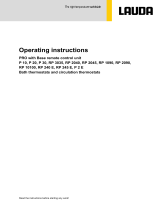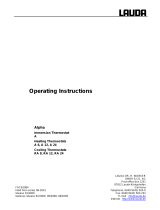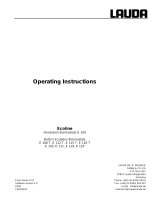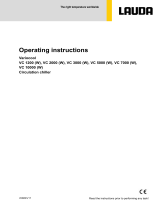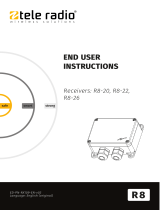Page is loading ...

Variocool NRTL process thermostats
Operation manual
VC 1200 NRTL, VC 1200 W NRTL, VC 2000 NRTL, VC 2000 W NRTL, VC 5000 NRTL, VC 5000 W NRTL,
VC 10000 NRTL, VC 10000 W NRTL
V03 Read this manual prior to performing any task!

Translation of the original operation manual
LAUDA DR. R. WOBSER GMBH & CO. KG
Laudaplatz 1
97922 Lauda-Königshofen
Germany
Telephone: +49 (0)9343 503-0
Fax: +49 (0)9343 503-222
E-mail: [email protected]
Internet: https://www.lauda.de
Q5WT-E_13-002, 3, en_US 02/07/2022 © LAUDA 2021
V03Variocool NRTL process thermostats2 / 119

Table of contents
1 Safety...................................................................................................................................................................................... 7
1.1 Safety notices................................................................................................................................................................. 7
1.2 Testing in accordance with the Industrial Safety and Health Ordinance................................................................ 9
1.3 EMC requirements....................................................................................................................................................... 9
1.4 Software versions.......................................................................................................................................................... 9
1.5 Observing additional operating instructions............................................................................................................. 10
1.6 Limits of the device..................................................................................................................................................... 10
1.6.1 Application limits...................................................................................................................................... 10
1.6.2 Environmental and operating conditions............................................................................................... 10
1.6.3 Time limits................................................................................................................................................... 11
1.7 Prohibition of modifications to the device................................................................................................................. 11
1.8 Materials......................................................................................................................................................................... 11
1.9 Fluorinated refrigerant................................................................................................................................................. 11
1.10 Heat transfer liquid requirements............................................................................................................................... 11
1.11 Hose requirements...................................................................................................................................................... 12
1.12 Personnel qualification................................................................................................................................................ 12
1.13 Personal protective equipment.................................................................................................................................. 12
1.14 Safety fittings on the device....................................................................................................................................... 12
1.14.1 Overtemperature protection................................................................................................................... 12
1.14.2 Low-level protection................................................................................................................................ 13
1.14.3 Product safety label.................................................................................................................................. 13
1.15 Structure of warnings.................................................................................................................................................. 13
2 Unpacking............................................................................................................................................................................. 15
3 Device description................................................................................................................................................................ 17
3.1 Structure....................................................................................................................................................................... 17
3.2 Mains switch................................................................................................................................................................. 18
3.3 Hydraulic circuit........................................................................................................................................................... 19
3.4 Rating label.................................................................................................................................................................. 20
3.5 Interfaces...................................................................................................................................................................... 21
4 Before starting up................................................................................................................................................................ 23
4.1 Install device................................................................................................................................................................. 23
4.2 Hoses............................................................................................................................................................................ 23
4.3 Connecting an external application.......................................................................................................................... 25
4.4 LAUDA heat transfer liquids..................................................................................................................................... 26
4.5 Cooling water requirements....................................................................................................................................... 27
4.6 Connecting the cooling water................................................................................................................................... 29
4.7 Configuring interfaces............................................................................................................................................... 30
V03 Variocool NRTL process thermostats 3 / 119

4.7.1 Configuring the floating contact (alarm output)................................................................................. 30
4.7.2 Interface potential-free contact............................................................................................................. 31
4.7.3 Configuring the Ethernet interface........................................................................................................ 31
4.7.4 Data transfer rate..................................................................................................................................... 37
4.7.5 Protocol of the interface......................................................................................................................... 38
4.7.6 Read commands of the Ethernet interface.......................................................................................... 38
4.7.7 Write commands of the Ethernet interface.......................................................................................... 41
4.7.8 Error messages for interface.................................................................................................................. 44
5 Commissioning.................................................................................................................................................................... 45
5.1 Establishing a mains connection............................................................................................................................... 45
5.2 Switching on the machine for the first time............................................................................................................ 46
5.3 Operating the device with the operating unit.......................................................................................................... 47
5.3.1 Home window, navigation and softkeys................................................................................................. 47
5.3.2 Input window and entering set temperatures....................................................................................... 48
5.3.3 Graph window.......................................................................................................................................... 50
5.4 Setting the heat transfer liquid................................................................................................................................. 50
5.5 Filling the device with filling mode and aeration....................................................................................................... 51
5.6 Control parameters.................................................................................................................................................... 53
5.6.1 Control basics........................................................................................................................................... 54
5.6.2 Overview of internal control parameters............................................................................................... 57
5.6.3 Overview of external control parameters.............................................................................................. 57
5.6.4 Activating the control variable............................................................................................................... 58
5.6.5 Adapting control parameters.................................................................................................................. 59
6 Operation............................................................................................................................................................................ 60
6.1 General warnings........................................................................................................................................................ 60
6.2 Operating modes......................................................................................................................................................... 61
6.3 Menu structure............................................................................................................................................................ 62
6.4 Set the setpoint oset................................................................................................................................................ 65
6.5 Limitation of heating and cooling.............................................................................................................................. 65
6.6 Cooling......................................................................................................................................................................... 66
6.7 Setting temperature limits Tih and Til....................................................................................................................... 66
6.8 Basic settings............................................................................................................................................................... 67
6.9 Calibrating the temperature probe........................................................................................................................... 70
6.10 Restore the factory setting........................................................................................................................................ 72
6.11 Viewing the device status........................................................................................................................................... 73
6.12 Programmer................................................................................................................................................................. 75
6.12.1 Basic information..................................................................................................................................... 75
6.12.2 Set and process program........................................................................................................................ 80
6.13 Setting the time, date, format and time zone.......................................................................................................... 82
V03
Variocool NRTL process thermostats4 / 119

6.14 Operator and viewer................................................................................................................................................... 83
6.15 Web server LAUDA Command................................................................................................................................ 86
6.16 Cloud service LAUDA.LIVE..................................................................................................................................... 89
6.17 Importing and exporting data..................................................................................................................................... 91
6.17.1 Importing data........................................................................................................................................... 91
6.17.2 Exporting data.......................................................................................................................................... 92
7 Maintenance........................................................................................................................................................................ 95
7.1 Warning notes for maintenance................................................................................................................................ 95
7.2 Maintenance intervals................................................................................................................................................ 95
7.3 Cleaning the device.................................................................................................................................................... 96
7.4 Checking the heat transfer liquid.............................................................................................................................. 96
7.5 Draining heat transfer liquid...................................................................................................................................... 96
7.6 Draining the cooling water circuit............................................................................................................................. 98
7.7 Cleaning cooling water circuit................................................................................................................................... 98
7.8 Checking the low-level protection......................................................................................................................... 100
7.9 Cleaning the air-cooled condenser......................................................................................................................... 101
8 Faults.................................................................................................................................................................................. 102
8.1 Alarms, errors and warnings..................................................................................................................................... 102
8.2 Alarms......................................................................................................................................................................... 102
8.3 Troubleshooting......................................................................................................................................................... 103
9 Decommissioning.............................................................................................................................................................. 105
9.1 Information on decommissioning............................................................................................................................ 105
10 Disposal.............................................................................................................................................................................. 106
10.1 Disposing of packaging............................................................................................................................................. 106
10.2 Disposing of refrigerant............................................................................................................................................ 106
10.3 Device disposal.......................................................................................................................................................... 106
11 Accessories......................................................................................................................................................................... 107
12 General............................................................................................................................................................................... 108
12.1 Copyright................................................................................................................................................................... 108
12.2 Technical changes..................................................................................................................................................... 108
12.3 Warranty conditions.................................................................................................................................................. 108
12.4 Contact LAUDA....................................................................................................................................................... 108
13 Technical data.................................................................................................................................................................... 109
13.1 Dimensions, temperatures, filling quantities and other data............................................................................... 109
13.2 Heating output............................................................................................................................................................. 111
13.3 Cooling output............................................................................................................................................................ 112
13.4 Refrigerant and filling weight..................................................................................................................................... 113
14 EC Declaration of Conformity and NRTL certificate.................................................................................................... 114
14.1 EC Declaration of Conformity................................................................................................................................. 114
V03 Variocool NRTL process thermostats 5 / 119

14.2 NRTL certificate......................................................................................................................................................... 115
15 Product Returns and Clearance Declaration................................................................................................................... 117
16 Glossary............................................................................................................................................................................... 118
V03Variocool NRTL process thermostats6 / 119

1 Safety
1.1 Safety notices
IMPORTANT
nBefore using the device, please read the operating manual carefully.
nThe information in this operating manual must be kept close at hand in
the immediate vicinity of the device.
nSave the operating manual for later reference.
nThis operating manual is part of the device. If the device is passed on, the
operating manual must be kept with it.
nThe operating manual is available on our homepage (www.lauda.de).
An overview of authorized personnel and protective equipment
can be found in Ä Chapter 1.12 “Personnel qualification”
on page 12 and Ä Chapter 1.13 “Personal protective equip-
ment” on page 12.
Refer to Ä Chapter 1.15 “Structure of warnings” on page 13 for
more information on the general structure of warnings.
The "Safe State" of the constant temperature equipment in the event of
overtemperature, low level or failure is defined as:
nHeating o.
nThe devices can only be operated as intended under the conditions
specified in this operating manual. Any other mode of operation is
considered to be unintended use and could compromise the protection
provided by the device.
nYou, the user, must check the functionality of the safety fittings of the
device. Observe the maintenance intervals.
nTransport the device carefully. The device must never be tilted or turned
upside down.
nThe device and the inside of the device could be damaged:
due to fall,
due to shock.
nThe device may only be operated by trained personnel.
nNever put the device into operation, if:
it is damaged,
it is leaking (for example, heat transfer liquid is escaping),
the mains cable and/or other cables are damaged.
nDo not install the device in areas with aggressive media.
nThe mounting surface must be tight, level, non-slip and non-combus-
tible. Do not place a table-top device on table edges.
nKeep the specified distance from other devices, objects or walls.
nProtect the device from dripping water or condensation.
nDo not store any liquids or combustible objects above the device.
nDo not handle flammable liquids in the immediate vicinity of the device.
Safety notices
V03 Variocool NRTL process thermostats 7 / 119

nDo not place heavy parts on the device.
nThe devices are intended for operation on grounded networks. Opera-
tion on IT networks, for example, is not permitted.
nSwitch o the device and pull out the mains plug,
before starting service or repair work,
when moving the device,
when installing or removing interface modules or accessories.
nDo not operate the device without heat transfer liquid.
nOnly skilled personnel are permitted to perform service and repair work.
nDrain the device completely before moving it.
nDo not make any technical modifications to the device.
nThe devices are not designed for use in medical applications in accord-
ance with DIN EN 60601-1 and IEC 601-1!
nOnly connect hydraulically closed consuming units to the device.
nFor pressure-sensitive consuming units (e.g., glass apparatus) with a
maximum permissible working pressure below the maximum pressure of
the device pump, a pressure relief device must be installed to protect
against gage pressure.
nParts of the device (e.g., pump, drain nozzles) can assume surface tem-
peratures over 70°C at higher operating temperatures (possible risk of
burns).
nAfter a power failure or deactivation of the device, parts of the device
may become hotter for a short time.
nUse suitable hoses.
nUse hose clips to prevent the hoses from slipping o the hose nozzle.
nCheck the hoses from time to time for possible material fatigue.
nHoses containing hot heat transfer liquid and other hot parts may not
come into contact with the mains cable.
nDo not operate the device if leaks have been detected. Ventilate the
installation room immediately.
nThe following actions may unintentionally restart the thermostat from
standby,
previously activated timer operation,
‘Start’ command over active interfaces on the device.
nObserve the permissible storage and operating temperatures of the
device.
nThe device may not be exposed to fire.
nThe device may only be operated with the casing mounted.
nBring the heat transfer liquid to room temperature before draining.
nWhen switching to another heat transfer liquid, clean the device inten-
sively and empty it completely. We recommended that you flush out the
device with the new heat transfer liquid.
nThe penetration of secondary liquids into the device (e.g., through a
defective heat exchanger provided by the customer) absolutely must be
prevented.
nObserve all product safety labels/safety marks on the device.
Additional safety information for water-cooled devices
nUse suitable cooling water to prevent corrosion in the cooling water
circuit.
nSecure the water cooling return hose in the outlet area to prevent the
hose from jerking suddenly, even when pressure surges occur.
V03Variocool NRTL process thermostats8 / 119

nSecure the water cooling return hose in the outlet area in such a way
that hot cooling water cannot spray out.
nAvoid bending or squeezing the return hose of the water cooling system.
Gage pressure can cause the cooling water hoses to rupture and hot
cooling water to escape.
nIn order to avoid damage caused by leakage of the cooling water system,
it is recommended to install a leakage water detector with water shut-
o.
Additional safety notices for process thermostats with water cooling
nProcess thermostats with a cooling water connection (type W) always
require a cooling water supply, even if the devices are only used for
heating.
1.2 Testing in accordance with the Industrial Safety and Health Ordinance
The national regulations for operation applicable in the country in which the
system is installed must be complied with. In particular, the application of
statutory regulations concerning operational safety must be observed.
1.3 EMC requirements
Table 1: Classification in accordance with EMC requirements
Device Immunity requirements Emissions class Customer power supply
Variocool NRTL process
thermostats Table 2 in accordance with
DIN EN 61326-1 (Industry) Emissions Class B in accord-
ance with CISPR 11
Only for EU
Domestic connection value
³ 100 A
Variocool NRTL process
thermostats Table 2 in accordance with
DIN EN 61326-1 (Industry) Emissions Class B in accord-
ance with CISPR 11
Rest of the world (outside
EU)
No limitation
"This equipment has been tested and found to comply with the limits for
Class A digital device, pursuant to Part 15 of the FCC (Federal Communica-
tion Commission) Rules. These limits are designed to provide reasonable
protection against harmful interference when the equipment is operated in a
commercial environment. This equipment generates, uses, and can radiate
radio frequency energy and, if not installed and used in accordance with the
instruction manual, may cause harmful interference to radio communica-
tions. Operation of this equipment in a residential area is likely to cause
harmful interference in which case the user will be required to correct the
interference at his own expense."
1.4 Software versions
This operating manual is valid for devices with the following software versions
or higher.
Obligations of the operator
Instructions for Class A digital device, USA
V03 Variocool NRTL process thermostats 9 / 119

Software Valid from version
Control system 1.39
Cooling system 1.19
Heating 1.16
1.5 Observing additional operating instructions
Additional interface modules can be fitted to the device. Before installing
and using interface modules, always read and observe the operating manual
accompanying the relevant interface module.
1.6 Limits of the device
1.6.1 Application limits
nThe process thermostat may only be used for the temperature control
and circulation of non-flammable heat transfer liquid through a closed
circuit. The heat transfer liquid is pumped through a hose to the external
closed consuming unit and flows through a hose back into the thermo-
stat. The heat transfer liquids and hoses to be used are listed in this
operating manual.
nOperation without heat transfer liquid
nOperation with heat transfer liquids, hoses or refrigerants other than
those specified in the operating manual
nOperation with a glass reactor without overpressure protection
nOperation on a non-closed hydraulic circuit
nOperation in case of an outdoor installation
nConnecting hoses incorrectly
nSetting an incorrect pump pressure
nUse for controlling the temperature of foodstus
nUse in explosive atmospheres
nUse as a medical device
nElectrical power (each device)
nCooling water (required for water-cooled process thermostat)
nSee the "Technical Data" chapter
1.6.2 Environmental and operating conditions
The device may only be used in the following areas:
nProduction, quality assurance, research and development in an industrial
environment
nOnly used inside buildings
nUse up to a height of 2,000 m above sea level
nAmbient temperature from 5°C to 40°C
Interface modules
Intended use
Reasonably foreseeable improper use
Type of power supply
Performance limits, operating values
V03Variocool NRTL process thermostats10 / 119

nMaximum relative humidity 80% at an ambient temperature of 31°C,
relative humidity linearly decreasing to 50% at 40°C.
nFluctuations of the mains voltage up to ±10 % of the nominal voltage.
nSurge category II
1.6.3 Time limits
Service life - The service life of the device is 10 years.
Maintenance intervals - See Ä Chapter 7.2 “Maintenance intervals”
on page 95
Maximum operating time
without interruption - The device is designed for unattended contin-
uous operation.
1.7 Prohibition of modifications to the device
Any technical modification of the device by the user is prohibited. Any
damage resulting from unauthorized modification is not covered by customer
service or the product warranty. Service work may only be performed by the
LAUDA Service department or a service partner authorized by LAUDA.
1.8 Materials
All parts that come into contact with heat transfer liquid are manufac-
tured from high-quality materials adapted to withstand the operating tem-
perature. High-quality stainless steels, copper, brass and premium-quality
heat-resistant plastics are used.
1.9 Fluorinated refrigerant
The cooling thermostats are operated with non-odorized refrigerant (fluori-
nated greenhouse gas), depending on the device model. There are no special
installation requirements due to the low refrigerant charge and hermetically
sealed design. The designation and refrigerant charge are specified on the
rating label.
1.10 Heat transfer liquid requirements
nHeat transfer liquids are used to control the temperature. Only LAUDA
heat transfer liquids are approved for use in the device. LAUDA heat
transfer liquids are liquids that have been tested and approved by
LAUDA DR. R. WOBSER GMBH & CO. KG.
nThe heat transfer liquids are suitable for a specific temperature range.
This temperature range must correspond with the temperature range of
your application.
nThe use of heat transfer liquids poses a risk of injury from high and
low temperatures if certain upper or lower temperature thresholds are
exceeded.
nRisks in handling the heat transfer liquid are specified in the safety
datasheet together with corresponding safety measures. The safety
datasheet of the heat transfer liquid must therefore be observed in order
to use the device as intended.
V03 Variocool NRTL process thermostats 11 / 119

1.11 Hose requirements
The hoses for the external hydraulic circuit must be resistant to:
nthe heat transfer liquid used
nthe pressure in the hydraulic circuit
nthe high and low working temperatures
1.12 Personnel qualification
Operating personnel
Operating personnel are personnel who have been instructed on how to use
the device as intended in line with the information in the operating manual.
Specialized personnel
Certain activities on the device must be performed by specialized personnel.
Specialized personnel are personnel whose education, knowledge, and expe-
rience qualify them to assess the function and risks associated with the
device and its use.
1.13 Personal protective equipment
Protective gloves
Protective gloves must be worn for certain tasks. The protective gloves must
comply with the standard DIN EN 374. The protective gloves must be
chemically resistant.
Protective work clothing
Protective clothing must be worn for certain tasks. This protective clothing
must meet the legal requirements for personal protective equipment. The
protective clothing should be long-sleeved. Additionally safety shoes are
required.
Safety glasses
Safety glasses must be worn for certain tasks. The safety glasses must
comply with the standard DIN EN 166. The glasses must be tightly closed
and equipped with side plates.
1.14 Safety fittings on the device
1.14.1 Overtemperature protection
The overtemperature protection is a safety fitting that prevents damage
due to excessively high temperatures. All safety-related components on the
device are shut down to prevent fire from posing a danger to the device
and environment. An alarm signal also indicates that the overtemperature
protection has been activated. The temperature at which the safety fitting
triggers is fixed and cannot be changed.
V03
Variocool NRTL process thermostats12 / 119

1.14.2 Low-level protection
The low-level protection is a safety fitting that prevents damage to the
device. If the heat transfer liquid level in the device falls below a specified
level, a warning is issued initially. If the level drops further, an alarm is
triggered and all safety-related components of the device are switched o.
Check the function of the low-level protection before using the device in
extended, unattended continuous operation.
1.14.3 Product safety label
A "Hot surface" graphical symbol is axed to the device. This symbol warns
against hot surfaces on the device. These surfaces must not be touched
during operation. These surfaces must be allowed to cool to room tem-
perature before they can be touched during other operation phases such as
servicing.
Some components on the device remain live after the main switch is turned
o. Before starting any service work, turn o the device at the main switch,
secure against reactivation and disconnect from the power supply.
1.15 Structure of warnings
nA warning of "dangerous" indicates an immediately dangerous situation.
nIf this warning is not observed, then death or severe, irreversible injury
could occur.
DANGER!
Type and source
Consequences of not following instructions
Measure 1
Measure...
Hot
Parts that remain live after the main switch
is turned o
Dangerous
V03 Variocool NRTL process thermostats 13 / 119

nA warning of "warning" indicates a possibly dangerous situation.
nIf this warning is not observed, then death or severe, irreversible injury
could occur.
WARNING!
Type and source
Consequences of not following instructions
Measure 1
Measure...
nA warning of "caution" indicates a possibly dangerous situation.
nIf this warning is not observed, then minor, reversible injury could occur.
CAUTION!
Type and source
Consequences of not following instructions
Measure 1
Measure...
A "notice" warns that dangers to property or the environment may exist.
NOTICE!
Type and source
Consequences of not following instructions
Measure 1
Measure...
Warning
Caution
Notice
V03Variocool NRTL process thermostats14 / 119

2 Unpacking
DANGER!
Transport damage
Electric shock
Closely inspect the device for transport damage prior to
commissioning!
Never operate a device that has sustained transport
damage!
Personnel: nOperating personnel
1. Unpack the device.
Keep the original packaging of the device for subsequent
transportation.
2. Check the device and accessories for completeness and transport
damage immediately after delivery.
If the device or accessories are damaged contrary to expect-
ations, immediately inform the shipping company so that a
damage report can be compiled and the transport damage
inspected. Also notify LAUDA Constant Temperature Equip-
ment Service department immediately. You will find the con-
tact information here Ä Chapter 12.4 “Contact LAUDA”
on page 108.
1. Remove the tightening straps.
2. Remove the cover (ramp).
3. Remove the protective carton.
4. Read and follow the instructions for unpacking and packing (LAUDA
document number Q4DT-VT01-002).
Keep the original packaging of the device for subsequent
transportation.
5. Check the device and accessories for completeness and transport
damage immediately after delivery.
If the device or accessories are damaged contrary to expect-
ations, immediately inform the shipping company so that a
damage report can be compiled and the transport damage
inspected. Also notify LAUDA Constant Temperature Equip-
ment Service department immediately. You will find the con-
tact information here Ä Chapter 12.4 “Contact LAUDA”
on page 108.
Unpacking VC 1200 (W) NRTL and VC
2000 (W) NRTL
Unpacking VC 5000 (W) NRTL and VC
10000 (W) NRTL
V03 Variocool NRTL process thermostats 15 / 119

Table 2: Accessories included as standard
Device type Designation Quantity Catalog number
Mains cable (for devices with single-phase power
supply) 1
Mains cable (for devices with three-phase power
supply) 1
VC 1200 (W) NRTL through
VC 5000 (W) NRTL Pump connection: Hose nozzle ¾" with union nut
¾" 2 EOA 004
VC 10000 (W) NRTL Pump connection: Hose nozzle 1" with union nut
1¼"
2 EOA 003
Devices with water cooling Hose nozzle ½" with screw cap ¾" 2 EOA 001
All devices Operating manual 1 --
All devices Instructions for unpacking and packing 1 --
V03Variocool NRTL process thermostats16 / 119

3 Device description
3.1 Structure
Fig. 1: VC 10000 NRTL
1 Mains switch
2 Filler nozzle with cover
3 Control panel
4 Interfaces
5 Front panel (ventilation openings only in case of air-cooled devices)
6 Ventilation openings (on both sides)
7 Four castors (front castors with locking brake)
V03 Variocool NRTL process thermostats 17 / 119

Fig. 2: Rear side of VC 10000 NRTL
1 Power supply
2 Rating label
3 Bypass adjusting wheel
4 Drain tap
5 Connecting sleeve for cooling water outlet (only available for water-
cooled devices)
6 Connecting sleeve for cooling water inlet (only available for water-
cooled devices)
7 Ventilation grid
8 Alarm output (interface 12N)
9 Module bays
10 Pump connection, inlet (pressure side)
11 Pump connection, outlet
3.2 Mains switch
The devices have a mains switch on the left side. This mains switch is
designed either as a toggle switch or as a rotary switch. Position [0] switches
the device o, while Position [I] switches it on.
V03
Variocool NRTL process thermostats18 / 119

Mains switch for single-phase devices
The toggle switch is also designed as a fuse switch. If the current is
too high, the toggle switch triggers and disconnects the device from
the mains supply. The device can be used again by switching the
toggle switch to Position [I]. If the toggle switch trips again, contact
LAUDA Service for Constant Temperature Equipment.
Mains switch for three-phase devices
Switch on the circuit breaker only by a qualified electrician!
The rotary switch is not designed as a fuse switch. The three-phase
devices have a separate built-in automatic fuse. If the automatic
fuse trips again, contact LAUDA Service for Constant Temperature
Equipment.
3.3 Hydraulic circuit
The Variocool NRTL process thermostat is a powerful device for the tem-
perature control and circulation of heat transfer liquid with a medium active
bath volume.
The powerful pressure pump in the device ensures the necessary flow. The
pump always delivers the heat transfer liquid at its maximum pressure. The
components of the external hydraulic circuit must be designed for this max-
imum pressure. If the maximum pressure of the pump must be lowered due
to the use of pressure-sensitive components in the external circuit, adjust
the built-in bypass accordingly.
In the event of a fault, large quantities of heat transfer liquid can flow back
into the device from the external circuit. To avoid flooding the device, refer
to the following section Ä “External hydraulic circuit” on page 19.
The hydraulic circuit in the device consists of the following components:
nBath boiler,
nLevel sensor,
nPump,
nBypass,
nHeating unit and
nEvaporator.
An external consuming unit is connected to the device through hoses that
are connected to the pump connectors.
Only closed external consuming unit can be used with the Variocool NRTL
devices as the pressure pump does not allow the level in the external volume
to be checked.
In order not to flood the device at standstill, shut-o valves must be used for
temperature control with quantities of liquid greater than the bath volume,
which prevent heat transfer liquid from flowing back when the pump is
stopped.
The external hydraulic circuit consists of the following components:
nHoses
nExternal consuming unit
nShut-o valves if pertinent
Hydraulic circuit in Variocool NRTL
External hydraulic circuit
V03 Variocool NRTL process thermostats 19 / 119

3.4 Rating label
The serial number of a LAUDA device is composed as follows:
nThe letter S,
nthe year of manufacture (two-digit),
nand a 7-digit number, whereby the last digit represents the consecutive
number of the device in the year of manufacture.
The specifications on the type plate are described in more detail in the
following table. Certain specifications depend on the equipment installed.
Specification Description
Type / Gerätetyp: Type of the device
Order No. / Bestell Nr.: Catalog number of the device
Serial No. / Serien Nr.: Serial number of the device
Refrigerant / Kältemittel I: Refrigerant used in refrigeration circuit 1 of the appliance for
cooling. The global warming potential (GWP) of the refrigerant is
given in brackets.
Filling charge / Füllmenge I: Filling weight of the refrigerant and corresponding size of the CO2
equivalent in tonnes.
PS high pressure / Hochdruck I: Maximum permissible working pressure on the high-pressure side
of the refrigeration circuit (compression, condensation)
PS low pressure / Niederdruck I: Maximum permissible working pressure on the low-pressure side
of the refrigeration circuit (expansion, evaporation)
Fig. 3: Type plate
V03Variocool NRTL process thermostats20 / 119
/


